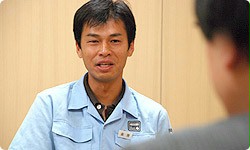2. Enough Work for Two Consoles
From planning to completion of the Nintendo DSi, I'm sure there were a lot of twists and turns, but looking back, what was hardest?
Hmm… I think it was the sudden big change in size. We'd finished the designs and were about ready to make the moulds.
Could you tell us about that?
Sure. Back in October of 2007, before we made the moulds, the designs were nearly complete, so we gathered the producers from the Entertainment Analysis and Development Division to unveil it within the company. The response wasn't that great, and, to tell the truth, we'd sort of been expecting that. According to the determined specifications, however, there was nothing we could do to stop it from turning out like that. We unveiled it to them, all the while doubting that it was going to be alright.
But you felt it was too late to suggest starting over.
Exactly. I made the presentation with all these uncertainties swirling around inside, and then at the end asked everyone if this was a game system they would want to own. The result was three to seven. Three people wanted it, seven didn't. And I imagine that since one of the designers was standing right there in front of them, some of them held back their true opinion. In truth, it was probably more like one to nine.
(laughs)
It was as bad as I had feared. We hastily rethought it, decided to remove a certain specification, and started over, heading toward the form it has today.

Umm, I think it might be easier to understand if I specified what that "certain specification" was. Originally, the Nintendo DSi was designed so that two DS games could be inserted.
Right. There were two slots.
There were a lot of requests among gamers, of course, and from in-house as well, for two slots. We also thought that would be good, and, even though we were aware of the drawback of increased size, we decided to proceed with two slots. But when you and your team made an actual model and I held it in my hands, all I could think was, "It's so big!"
Compared to the final version, it was much bigger. It was about three millimeters thicker too.
When you try to add two slots, it can't be helped. So you gave up on that, and decided to make it smaller.
Yes. That size change was hard. It left quite an impression on me.
At the unveiling, the internal designs were already finished. You had decided on the configuration of parts, evaluated prototypes, and checked durability and assembly. You thought it was all behind you. Then, just when it was about to be manufactured, you had to change the size! You had to do the work for two systems!

I really did! (laughs) Well, this is Nintendo. We're known the world over for our culture of "upending the tea table"*!
* "Upending the tea table" (chabudai gaeshi), is a reference to the classic Japanese comic and animated series, Hoshi of the Giants. The father in the series once upended the tea table while the family was eating a meal. Shigeru Miyamoto's working style has been compared to this because of his tendency to make last-minute suggestions that leave everyone else scrambling to implement them before the deadline.
I wonder what upending the tea table would be like for hardware design! (laughs)
(laughs)
Of course, that decision pushed back the release date, and you had to give up the double-slot design. But it was more important that lots of people who would see the Nintendo DSi would want one.
That's right.
What happened next?
After that, everything sped up. As we had already nailed down the internal structure, we moved on to the next level of more difficult design. The schedule was incredibly tight, but the internal designers were amazing about cooperating. Many of them had been making suggestions for slimming it down ever since we unveiled the much larger shell. Even though they had already completed one round of designs!
I suppose everyone realised something needed to be done about the thickness.
Yeah. So when I told them we had to do it over again, they were glad.
Even though it meant more work! (laughs)
Yeah. But I was really happy about it.
So in the end you had to draw up two sets of designs. With regard to the size change, some might say you should've known ahead of time the unit was going to be too big, but there's a big difference between looking at the parts and blueprints and working with a non-working design model, as to having in your hands a working model close to the real thing. I do have to say that when the first machine was made and we actually held it in our hands, it looked big and felt heavy. I'll ask Ehara-san about that.
I'm Yui Ehara. I designed the Nintendo DSi's outer shell.

You also worked on the body for the DS Lite, didn't you?
Yes, that's right.
As someone who designed the housing, what did you think about changing the size and making it all over again? I imagine you wondered why no one had thought of it sooner!
Yeah, I was like, "Don't you think it's a little late?!"
(laughs)
What does it mean to make the Nintendo DS thinner? Electronic devices the world over are incredibly thin. Like cell phones and electronic dictionaries. When compared with those things, the DS doesn't look that thin, so when we talk about its thinness, a lot of people might not understand why we are making such a big deal. I think it's important to note that the thinking behind durability for the DS and for cell phones are vastly different.
That's right. First there's the problem of durability. Certain products have got to be able to withstand certain amounts of impact. The amount of faith you have in a product that it will be difficult to break. That's one big point of difference. We pay a lot of attention to that when we make something. Also, when you compare it with other electronic devices, an overwhelming number are produced of one single model, so you even have to think about the lifespan of the mould.

Yes, that makes sense. You have to use a design and materials that will place as little a burden on the mould as possible.
Another thing is the price. It costs a lot more to manufacture today's ultra-thin cell phones than it does a game console, but you have to be able to keep the cost of a handheld game console below 20,000 yen (£178). That introduces a restriction on the materials you can use. It isn't quite an apt comparison to simply say there are smaller electronic devices out there.
It was important in making the DS that we had to achieve the best balance of visual design, usability, internal structure, durability, mass production and manufacturing cost. If we weren't making that many, we could incorporate manual procedures or use special materials, but when you're mass producing on the scale that we do, you can't do that.
That's right.
Within those constraints, you've always got lots of ideas for making your devices slimmer. What did you do this time?
As far as design goes, we tried to cut down on unused space as much as possible. We changed the location for the CPU and raised the house for the battery. The guys in charge of board design really put their shoulders to the wheel. The parts are really packed in, but we were under pressure to keep the price down…
Sorry about that. (laughs)
Sorry I had to mention it. (laughs)
So you decreased the number of slots, and unveiled the new, slimmer DS within the company. Was the response better than the first time?
Absolutely. Everyone immediately said it was much better.